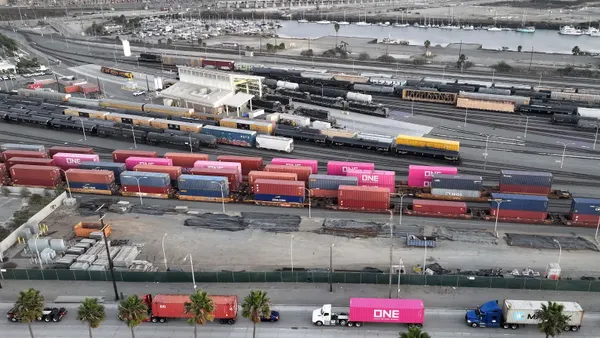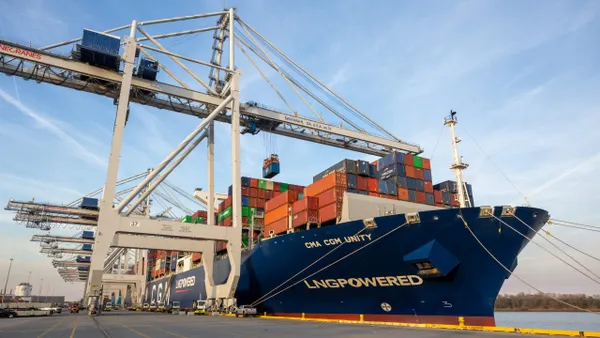Dive Brief:
- The Port of Los Angeles had its busiest February in its history, with loaded imports reaching 412,884 TEUs — a nearly 53% YoY increase and an almost 19% uptick compared to 2019, according to figures from the port released Tuesday.
- Dwell times at the terminal are showing signs of improvement, but Executive Director Gene Seroka said he still considers the figures to be high. Container dwell on terminals is 4.1 days, down from five in January. And street dwell time waiting for warehouse space averaged 6.3 days for a 40-foot container in February, which is down from 7.6 in January, Seroka said.
- "We need to cut both the terminal and street dwell time to pre-pandemic level," he said.
Dive Insight:
The consumer-driven import surge that has stressed Port of Los Angeles' operations is not showing any sign of letting up, Seroka said.
"With more people getting vaccinated, the latest stimulus checks in the mail and in-store safety protocols increasing, there are more options for American buyers," he said.
Retail sales did drop more than 3% in February compared to the previous month, according to the latest release from the Census Bureau. But economists have said this was more a result of the winter weather than an indication of a slowing economy.
The National Retail Federation said it expects retail sales to grow between 6.5% and 8.2% YoY in 2021.
"With another round of stimulus checks being mailed right now, we expect another large boost in consumer spending over the next few months," NRF Chief Economist Jack Kleinhenz said in a statement Tuesday.
Multiple ports across the country saw their imports surge in February. Import levels were up 26% YoY in Oakland, California, and 10% YoY at the Northwest Seaport Alliance. Figures from S&P Global Market Intelligence's Panjiva show that overall U.S. seaborne imports in February were up more than 29% YoY and up 20% compared to the same month in 2019.
"The growth in imports of consumer discretionary products was broad-based in the first two months of the year, including a 28.5% increase in consumer electronics despite the emergent semiconductor shortages, and a 41.8% increase in home furnishings," S&P wrote in a research note. "Even the apparel sector returned to growth with a 12.8% rise in February, bringing the first-quarter-to-date total to a 4.8% improvement."
Imports show little sign of letting up at the Port of Los Angeles, with its three-week forecast currently showing import levels will be more than doubling 2020 levels through the first three days of April.
There were just 17 container ships at anchor in the San Pedro Bay Tuesday, with 10 of those heading to the Port of Los Angeles, which is the lowest figure since December 2020, Seroka said. But the port does expect 18 more vessels to arrive over the next five days.
Hapag-Lloyd's latest regional update for North America said that shortages of labor, trucking capacity and rail capacity mean that congestion at the California ports of Los Angeles and Long Beach are still affecting shippers.
"All terminals continue to suffer from severe congestion due to the spike in import volumes," Hapag-Lloyd wrote.
Seroka said that improving the container flow will require getting vaccinations for the dock workers, truckers, terminal employees and warehouse labor in the region to get operations running at full capacity. It also requires that importers pick up cargo quickly from the port. And increased sharing of data could also improve the situation, he said.
"We need to share this data specifically across our port community system, employ a deep reservation system for truck movement, broadly segment cargo to increase gate fluidity — especially at business times during normal hours," Seroka said.
Seroka said that some shippers are looking for alternative sourcing to improve supply chain bottlenecks they are currently experiencing, but they're working with partners to find efficiencies. He underscored just how unprecedented the current situation is, even with a more efficient system.
"I don't think there's going to be one lever that we can push or pull for that matter, to be able to find ourselves never talking about port congestion again," he said. "It's a confluence of events that hit all at one time, from a 100-year pandemic to a manufacturing squeeze and a consumer buying pattern that had never been anticipated before."














